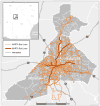Time and distance barriers to mammography facilities in the Atlanta metropolitan area
- PMID: 21267639
- PMCID: PMC5836475
- DOI: 10.1007/s10900-011-9359-5
Time and distance barriers to mammography facilities in the Atlanta metropolitan area
Abstract
To a great extent, research on geographic accessibility to mammography facilities has focused on urban-rural differences. Spatial accessibility within urban areas can nonetheless pose a challenge, especially for minorities and low-income urban residents who are more likely to depend on public transportation. To examine spatial and temporal accessibility to mammography facilities in the Atlanta metropolitan area by public and private transportation, we built a multimodal transportation network model including bus and rail routes, bus and rail stops, transfers, walk times, and wait times. Our analysis of travel times from the population-weighted centroids of the 282 census tracts in the 2-county area to the nearest facility found that the median public transportation time was almost 51 minutes. We further examined public transportation travel times by levels of household access to a private vehicle. Residents in tracts with the lowest household access to a private vehicle had the shortest travel times, suggesting that facilities were favorably located for women who have to use public transportation. However, census tracts with majority non-Hispanic black populations had the longest travel times for all levels of vehicle availability. Time to the nearest mammography facility would not pose a barrier to women who had access to a private vehicle. This study adds to the literature demonstrating differences in spatial accessibility to health services by race/ethnicity and socioeconomic characteristics. Ameliorating spatial inaccessibility represents an opportunity for intervention that operates at the population level.
Figures
Similar articles
-
Racial disparities in travel time to radiotherapy facilities in the Atlanta metropolitan area.Soc Sci Med. 2013 Jul;89:32-8. doi: 10.1016/j.socscimed.2013.04.018. Epub 2013 Apr 29. Soc Sci Med. 2013. PMID: 23726213 Free PMC article.
-
Geographic access to mammography facilities and frequency of mammography screening.Ann Epidemiol. 2018 Feb;28(2):65-71.e2. doi: 10.1016/j.annepidem.2017.11.012. Epub 2017 Dec 7. Ann Epidemiol. 2018. PMID: 29439783 Free PMC article.
-
Rural-urban difference in female breast cancer diagnosis in Missouri.Rural Remote Health. 2015 Jul-Sep;15(3):3063. Epub 2015 Jul 29. Rural Remote Health. 2015. PMID: 26223824
-
Barriers to mammography screening among racial and ethnic minority women.Soc Sci Med. 2019 Oct;239:112494. doi: 10.1016/j.socscimed.2019.112494. Epub 2019 Aug 20. Soc Sci Med. 2019. PMID: 31513931 Review.
-
Depression as a risk factor for underuse of mammography.J Womens Health (Larchmt). 2004 Jul-Aug;13(6):739-42. doi: 10.1089/1540999041783136. J Womens Health (Larchmt). 2004. PMID: 15333289 Free PMC article. Review. No abstract available.
Cited by
-
Governmental Investments in Hospital Infrastructure Among Regions and Its Efficiency in China: An Assessment of Building Construction.Front Public Health. 2021 Oct 20;9:719839. doi: 10.3389/fpubh.2021.719839. eCollection 2021. Front Public Health. 2021. PMID: 34746077 Free PMC article.
-
Cost-effectiveness of patient navigation for breast cancer screening in the National Breast and Cervical Cancer Early Detection Program.Cancer Causes Control. 2019 Sep;30(9):923-929. doi: 10.1007/s10552-019-01200-3. Epub 2019 Jul 11. Cancer Causes Control. 2019. PMID: 31297693 Free PMC article.
-
Comparing GIS-based measures in access to mammography and their validity in predicting neighborhood risk of late-stage breast cancer.PLoS One. 2012;7(8):e43000. doi: 10.1371/journal.pone.0043000. Epub 2012 Aug 28. PLoS One. 2012. PMID: 22952626 Free PMC article.
-
Addressing Disparities Related to Access of Multimodality Breast Imaging Services Before and During the COVID-19 Pandemic.Acad Radiol. 2022 Dec;29(12):1852-1860. doi: 10.1016/j.acra.2022.03.017. Epub 2022 Mar 25. Acad Radiol. 2022. PMID: 35562265 Free PMC article. Review.
-
Primary care characteristics and their association with health screening in a low-socioeconomic status public rental-flat population in Singapore- a mixed methods study.BMC Fam Pract. 2016 Feb 6;17:16. doi: 10.1186/s12875-016-0411-5. BMC Fam Pract. 2016. PMID: 26851939 Free PMC article.
References
-
- Berry DA, Cronin KA, Plevritis SK, Fryback DG, Clarke L, Zelen M, Mandelblatt JS, Yakovlev AY, Habbema JD, Feuer EJ, Cancer I Surveillance Modeling Network C. Effect of screening and adjuvant therapy on mortality from breast cancer. N Engl J Med. 2005;353:1784–1792. - PubMed
-
- Kalager M, Zelen M, Langmark F, Adami HO. Effect of screening mammography on breast-cancer mortality in Norway. New England Journal of Medicine. 2010;363:1203–1210. - PubMed
-
- US Preventive Services Task Force. Screening for breast cancer: U.S. Preventive Services Task Force recommendation statement. Annals of Internal Medicine. 2009;151:716–726. W-236. - PubMed
-
- Lee CH, Dershaw DD, Kopans D, Evans P, Monsees B, Monticciolo D, et al. Breast cancer screening with imaging: recommendations from the Society of Breast Imaging and the ACR on the use of mammography, breast MRI, breast ultrasound, and other technologies for the detection of clinically occult breast cancer. Journal of the American College of Radiology. 2010;7:18–27. - PubMed
Publication types
MeSH terms
Grants and funding
LinkOut - more resources
Full Text Sources
Medical


